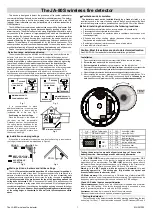
Interface
IV’s parameters are described below, followed by the
corresponding Desmodus Versio parameter in parentheses
for ease of use when reflashing.
Blend (Blend):
Wet/dry mix between the input signal and
the resulting delay.
Regen (Regen):
Feedback amount for the delay lines.
Turning this control past 3:00 ducks the delay line based on
the input, creating sidechain-type effects. Regen is a
sensitive control and while you are learning the module you
may have best results if you keep it relatively low.
Skew (Speed) [bipolar]:
Changes the relative timing of the
delay taps. In the center, the spacing between taps is equal.
To the left, the spacing starts fast and gets slower. To the
right, the spacing starts slow and gets faster. Useful for a
variety of effects like bouncing ball to the left and dying
clock to the right.
Angle (Tone) [bipolar]:
Imagine that the delay taps are
arranged in a circle in the L/R space. This control sets the
amount that each tap is offset in that circle relative to the
previous tap. For instance, at 1:00, the second tap will be
rotated slightly further right than the previous, and the tap
after that would be rotated even more, eventually looping
back to the left side of the circle. At extreme clockwise/
counterclockwise values, taps bounce around the stereo field wildly.
LFO (Index) [bipolar]:
Adds modulation and wide bandpass filtering to the delay line.
To the left the modulation is random, to the right it is triangular. Think of LFO as a
“warble” control with two flavors of warbliness.
Time (Size):
How much time there is before the first delay as a fraction of the Spread
setting.
Spread (Dense):
Base delay time. This sets the time from now until the last tap. When
using a tap or external clock, this acts as a clock divider/multiplier.
LIM/DST/SHM:
Delay mode that changes how the feedback path is processed: clean,
slightly distorted, and pitch-shifted shimmer.
>/=/< (BND/LRP/JMP):
Changes how the 12 delay taps behave. To the left, the taps
decrescendo. To the right, the taps crescendo. In the center, all taps are equal volume.
Tap (FSU):
Tap tempo. Output LEDs flash purple each time a clock pulse/tap is
received. Holding down the button for 2 seconds clears the tapped tempo (LEDs flash
orange) and the Size and Dense knobs then control timing entirely. Holding down the
button for 5 seconds clears the delay lines completely (LEDs flash white). The
corresponding jack acts as a clock input.
4























